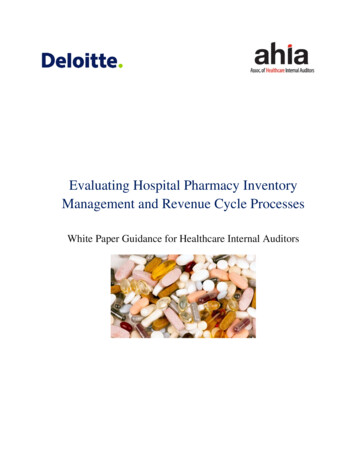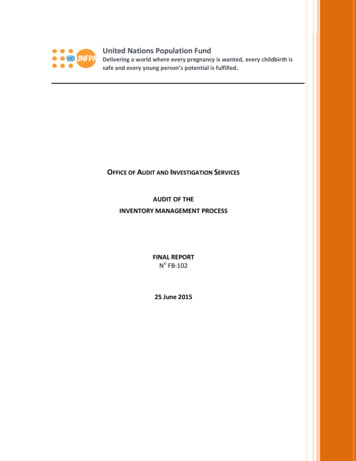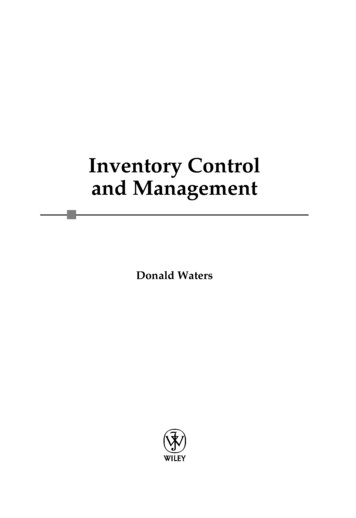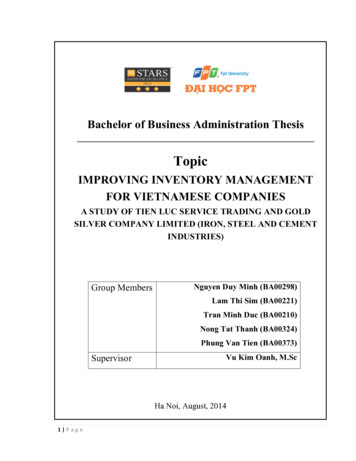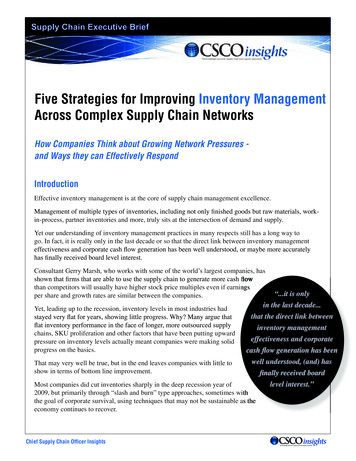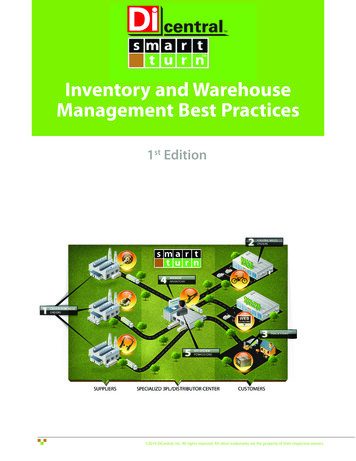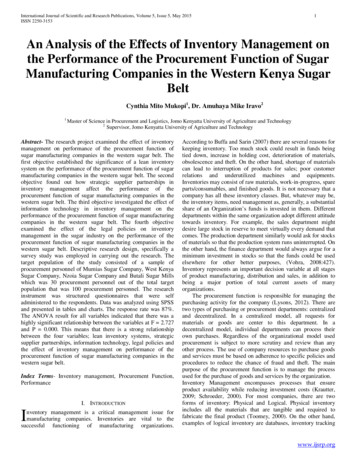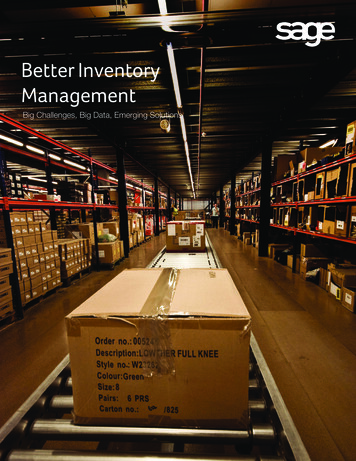
Transcription
Hospital InventoryManagementNew Trends in HealthcareClaudia RosalesMichigan State UniversityMichael Magazine and Uday RaoUniversity of CincinnatiIn collaboration withSylvain Laundry – HEC MontrealRichard Philippe – Logi-D The Eli Broad College of Business,Michigan State University, 2015
Problem Motivation Supplies management – significant costs involved 30-40% ofthe average hospital’s budget (Neil, 2005) Many different supplies Many different locations Little or no visibility of inventory at point-of-use Stock rotation is critical Focus on patient care2 The Eli Broad College of Business,Michigan State University, 2015
Traditional Hospital InventoryPracticesService CentersNurse ServersCentral Warehouse3 The Eli Broad College of Business,Michigan State University, 2015
Literature ReviewInventory management at hospitals Bijvank and Vis (2012) Little and Coughlan (2008) Lapierre and Ruiz (2007) Opolon, et al. (2009) Landry and Beaulieu (2009)Impact of technology adoption Delen (2007) Lee and Ozer (2007) Gaukler et al. (2008) Cakici et al. (2010)4 The Eli Broad College of Business,Michigan State University, 2015
Dealing with inventory complexities– Automated DispensingMachines (ADMs) Computerized cabinet allowsinventory visibility at point-ofuse 90% of large hospitals ( 300beds) have ADMs (*)– Hospital Substituted nurseservers for Pyxis SupplyStations(*)Pedersen et al., 20065 The Eli Broad College of Business,Michigan State University, 2015
New TechnologyBenefits of ADMs Improve the dispensing and control of medicalsupplies Allows continuous time tracking of inventory Improve billing accuracy Enabled the use of new/improved inventoryreplenishment practices Hospital management unsure how to takeadvantage of new technology6 The Eli Broad College of Business,Michigan State University, 2015
New Inventory PracticesUsing ADMs– Inventory is tracked continuously A par valueRefill levelCritical levelStockout levelReplenish at start of every shift - (S,s)Replenish between shifts – (Q,R) Between shifts if inventory hits critical level - item is replenished– Should we replenish if close to periodic replenishment?– What are the benefits of allowing the replenishment of a critical item?– How much improvement do we get versus traditional periodicreplenishment?7 The Eli Broad College of Business,Michigan State University, 2015
What Makes this Problem Challenging? Hybrid Inventory Policy– Periodic (s,S) replenishment – Beginning of shift– Continuous (Q,R) replenishment – out of cycle –whenever needed Optimal policy – likely non-stationaryBehavior of non-stationary R8 The Eli Broad College of Business,Michigan State University, 2015
What Makes this Problem Challenging? There is a “fixed cost” of performing a replenishment the out-of-cycle replenishment is considered morecostlyout of cycle fixed cost (ko) periodic fixed cost (kp) There is no restriction to the number of out-of-cyclereplenishments Holding costs associated with limited space available Penalty cost when stock-outs occur wasting valuablenurse time Many items ( 100)9 The Eli Broad College of Business,Michigan State University, 2015
Single Item Hybrid PolicySolution Approach No simple closed formexpression for average costgiven s,S,R,Q Cost function – not convex1. Develop a stochasticoptimization heuristic usingsimulation2. Obtain approximateparameter expressionsusing the optimal solution todeterministic Hybrid policy10 The Eli Broad College of Business,Michigan State University, 2015
Optimization Heuristic Search heuristic– Coded in C – Iteratively searches for (R,Q) and (s,S) values until convergence isreached– Heuristic is re-started with different starting points looking for betterlocal optima– Simulation is used to evaluate long run average cost Cost within 1% of optimal vs. exhaustive grid search Heuristic used to test different scenarios11 The Eli Broad College of Business,Michigan State University, 2015
Hybrid Cost Function12 The Eli Broad College of Business,Michigan State University, 2015
Single Item - Insights Obtained High economic benefits possible for hybrid - up to 18%improvement Significant differences observed in parameter values –S Speriodic Hybrid – flexible, can behave as periodic policy, orapproach continuous policy Hybrid provides maximum benefit when cost of periodicand continuous policy is equal13 The Eli Broad College of Business,Michigan State University, 2015
Approximate Solution From DeterministicHybrid Estimates for the stochastic hybrid policyparameters( S s) ( Sd* sd* )Q Qd*s sd* safety stock (periodic replenishment interval order lead time)R Rd* safety stock (order lead time)– Estimated parameters performed well for hospitalconditions tested– Parsimonious solution for large number of items stillneeded14 The Eli Broad College of Business,Michigan State University, 2015
Dealing with Multiple ItemsThe Two-Bin System Motivated by lean principles Each item’s inventory stored in two bins –primary and secondary Stock from primary bin is consumed first secondary bin becomes the new primary No manual counting necessary / No need totrack individual item consumption Number of items per bin usually selected toprovide a pre-specified number of inventoryturns.15 The Eli Broad College of Business,Michigan State University, 2015
Two Bin System - Advantages No need to track individual item inventory continuously Fewer parameters to be defined for inventory control Replenishment can be triggered periodically or byaccumulation of empty bins Can be used for all types of products (drugs, supplies,office, etc)16 The Eli Broad College of Business,Michigan State University, 2015
Two-Bin Replenishment System with RFID Each bin carries one RFID tag When a bin is emptied, the RFID tag isplaced on the board and read Information is downloaded to MMinformation system Depending on system conditions, a replenishment is triggered If order triggered – stock delivered after some time While replenishment is processed – more bins may become empty17 The Eli Broad College of Business,Michigan State University, 2015
Two Bin-RFID System in Hospitals Hospitals used to periodic replenishment – With RFID – hospitals don’t always take advantage of additionalinformation– system conditions that should trigger replenishment are notdefined Several factors may trigger an order– When a predetermined number of tags appear on the board– When a tag of a primary bin has been on the board for apredetermined period of time– When the tag of a secondary bin appears on the board18 The Eli Broad College of Business,Michigan State University, 2015
Hospital Data Access to over one year of data Data for two different hospitals19P2124C P2124C1002720 Bandage rayonne extensibleN non sterile9 10.0cm5 xP 4.5mP2124C P2124C1002720 Bandage rayonne extensibleN non sterile9 10.0cm5 xP 4.5mP2124C P2124C1002720 Bandage rayonne extensibleN non sterile9 10.0cm5 xP 4.5mP2124C P2124C1002720 Bandage rayonne extensibleN non sterile9 10.0cm5 xP 4.5mP2124C P2124C1002720 Bandage rayonne extensibleN non sterile9 10.0cm5 xP 4.5mP2124C P2124C1002720 Bandage rayonne extensibleN non sterile9 10.0cm5 xP 4.5mP2124C P2124C1002720 Bandage rayonne extensibleN non sterile9 10.0cm5 xP 4.5mP2124C P2124C1002720 Bandage rayonne extensibleN non sterile9 10.0cm5 xP 4.5mP2124C P2124C1002720 Bandage rayonne extensibleN non sterile9 10.0cm5 xP 4.5mP2124C P2124C1002720 Bandage rayonne extensibleN non sterile9 10.0cm5 xP 4.5mP2124C P2124C1002720 Bandage rayonne extensibleN non sterile9 10.0cm5 xP 4.5mP2124C P2124C1002720 Bandage rayonne extensibleN non sterile9 10.0cm5 xP 4.5mP2124C P2124C1002738 Bandage rayonne extensibleN non sterile9 15.0cm6 xP 4.5mP2124C P2124C1002738 Bandage rayonne extensibleN non sterile9 15.0cm6 xS 4.5mP2124C P2124C1002738 Bandage rayonne extensibleN non sterile9 15.0cm6 xP 4.5mP2124C P2124C1002738 Bandage rayonne extensibleN non sterile9 15.0cm6 xP 4.5mP2124C P2124C1002738 Bandage rayonne extensibleN non sterile9 15.0cm6 xS 4.5mP2124C P2124C1002738 Bandage rayonne extensibleN non sterile9 15.0cm6 xP 4.5mP2124C P2124C1002738 Bandage rayonne extensibleN non sterile9 15.0cm6 xP 4.5mP2124C P2124C1002738 Bandage rayonne extensibleN non sterile9 15.0cm6 xP 4.5mP2124C P2124C1002738 Bandage rayonne extensibleN non sterile9 15.0cm6 xS 4.5mP2124C P2124C1002738 Bandage rayonne extensibleN non sterile9 15.0cm6 xS 4.5mP2124C P2124C1002738 Bandage rayonne extensibleN non sterile9 15.0cm6 xS 4.5mP2124C P2124C1002738 Bandage rayonne extensibleN non sterile9 15.0cm6 xS 4.5mP2124C P2124C1002738 Bandage rayonne extensibleN non sterile9 15.0cm6 xS 4.5mP2124C P2124C1002738 Bandage rayonne extensibleN non sterile9 15.0cm6 xS 4.5mP2124C P2124C1002738 Bandage rayonne extensibleN non sterile9 15.0cm6 xS 4.5mP2124C P2124C1002738 Bandage rayonne extensibleN non sterile9 15.0cm6 xP 4.5mP2124C P2124C1002738 Bandage rayonne extensibleN non sterile9 15.0cm6 xS 4.5mP2124C P2124C1002738 Bandage rayonne extensibleN non sterile9 15.0cm6 xP 4.5mP2124C P2124C1002738 Bandage rayonne extensibleN non sterile9 15.0cm6 xS 4.5mP2124C P2124C1002738 Bandage rayonne extensibleN non sterile9 15.0cm6 xP 4.5mP2124C P2124C1002738 Bandage rayonne extensibleN non sterile9 15.0cm6 xP 4.5mP2124C P2124C1002738 Bandage rayonne extensibleN non sterile9 15.0cm6 xP 4.5m The Eli Broad College of Business,P2124C P2124C1002738 Bandage rayonne extensibleN non sterile9 15.0cm6 xP 4.5mMichigan State University, 2015P2124C P2124C1002738 Bandage rayonne extensibleN non sterile9 15.0cm6 xP 4.5m1 PQT (12/UN1 PQT (12/UN1 PQT (12/UN1 PQT (12/UN1 PQT (12/UN1 PQT (12/UN1 PQT (12/UN1 PQT (12/UN1 PQT (12/UN1 PQT (12/UN1 PQT (12/UN1 PQT (12/UN1 PQT (6/UNI1 PQT (6/UNI1 PQT (6/UNI1 PQT (6/UNI1 PQT (6/UNI1 PQT (6/UNI1 PQT (6/UNI1 PQT (6/UNI1 PQT (6/UNI1 PQT (6/UNI1 PQT (6/UNI1 PQT (6/UNI1 PQT (6/UNI1 PQT (6/UNI1 PQT (6/UNI1 PQT (6/UNI1 PQT (6/UNI1 PQT (6/UNI1 PQT (6/UNI1 PQT (6/UNI1 PQT (6/UNI1 PQT (6/UNI1 PQT (6/UNI1 PQT (6/UNI1/3/11 11:23 AM1/4/11 7:33 AM1/4/11 10:29 AM1/21/11 10:31 AM1/22/11 8:03 AM1/22/11 11:08 AM1/26/11 3:20 PM1/27/11 7:37 AM1/27/11 10:31 AM2/6/11 1:22 PM2/7/11 7:34 AM2/7/11 10:37 AM2/9/11 1:55 PM2/10/11 7:32 AM2/10/11 10:24 AM4/4/11 4:03 PM4/5/11 7:31 AM4/5/11 10:29 AM4/20/11 10:10 AM4/21/11 7:29 AM4/21/11 10:26 AM5/9/11 8:50 AM5/10/11 7:30 AM5/10/11 10:36 AM6/5/11 3:54 PM6/6/11 7:30 AM6/6/11 10:24 AM6/16/11 9:23 AM6/17/11 7:28 AM6/17/11 10:40 AM6/24/11 3:55 PM6/25/11 7:50 AM6/25/11 11:10 AM7/10/11 8:21 AM7/11/11 7:36 AM7/11/11 10:28 AM6/30/10 10:42 AM7/1/10 7:39 AM7/1/10 9:38 AM7/12/10 11:39 AM7/13/10 7:37 AM7/13/10 10:41 AM7/12/10 11:39 AM7/13/10 7:37 AM7/13/10 10:41 AM7/24/10 11:55 AM7/26/10 7:36 AM7/26/10 11:23 AM7/29/10 1:41 PM7/30/10 7:32 AM7/30/10 10:56 AM7/29/10 1:41 PM7/30/10 7:32 AM7/30/10 10:54 AM8/6/10 9:28 AM8/7/10 8:07 AM8/10/10 9:26 AM8/6/10 9:28 AM8/7/10 8:07 AM8/10/10 9:26 AM8/6/10 9:29 AM8/7/10 8:07 AM8/7/10 1:27 PM8/6/10 9:29 AM8/7/10 8:07 AM8/7/10 1:27 PM8/10/10 9:12 AM8/11/10 7:31 AM8/11/10 9:25 AM8/10/10 9:12 AM8/11/10 7:31 AM8/11/10 9:25 AM8/29/10 10:22 AM8/30/10 7:36 AM8/30/10 9:40 AM8/29/10 10:22 AM8/30/10 7:36 AM8/30/10 9:40 AM2010-09-09 03:28:46.000 2010-09-09 07:36:51.870 2010-09-09 09:28:15.0002010-09-13 08:41:36.000 2010-09-14 07:36:26.040 2010-09-14 09:24:01.0002010-09-14 08:47:06.000 2010-09-15 07:34:02.550 2010-09-15 09:33:52.0002010-09-16 10:47:09.000 2010-09-17 07:37:01.480 2010-09-17 09:23:12.0002010-09-17 08:39:21.000 2010-09-18 08:58:30.790 2010-09-18 11:40:35.0002010-09-18 12:01:42.000 2010-09-19 07:56:52.580 2010-09-19 10:27:55.00010/2/10 8:15 PM10/3/10 8:05 AM10/3/10 11:46 AM10/11/10 4:00 PM10/12/10 7:42 AM10/12/10 10:47 AM10/21/10 4:04 PM10/22/10 7:37 AM10/22/10 9:06 AM10/23/10 4:04 PM10/24/10 7:58 AM10/24/10 10:20 AM
Hospital Data Hospital Data – using a Two-Bin RFID System under periodicreview– Several departments within the hospital– Data for one year / hundreds of different itemsHospitalItem CodeDepartmentE35118901713Item Description units/bin Bin typeAdultIntravascularcatheter 1”padsIncontinence36PBin on BoardReplenishment ReplenishmentOrderedCompleted6/27/11 8:02 PM 6/28/11 7:20 AM 6/28/11 11:24 AM We were able to obtain from the data:– Average demand rates for each item– Number of item’s per department– Average replenishment lead time– Hospital provided information for fixed order cost and stockoutcosts20 The Eli Broad College of Business,Michigan State University, 2015
Two Bin System - Options for Improvement Traditionally bins replenished daily (periodically) - filling up allempty bins Bin replenishment involves time/effort fixed replenishment cost In case of stockouts – nurse procures item stockout cost Too many items to replenish Cost-efficient & practical21 The Eli Broad College of Business,Michigan State University, 2015
Two Bin System - Options for Improvement1) Improvement: Parameter Improvement– Optimize periodic review parameters to minimize cost – Find rightreplenishment cycle (daily, weekly, etc.)– Assuming bin demand follows a Poisson Process– Average cost per unit time JP(T) ; T periodic replenishment cycle (decisionvariable)Model parameters:L delivery lead time; N number of items; r stockout costs per unit ;r stockout cost per unit time; l bin consumption rate; K fixed ordercost22 The Eli Broad College of Business,Michigan State University, 2015
1) Parameter Improvement . We show quasi-convexity of JP(T) with respect to T (underconditions we specify). We can find the optimal average cost for the periodic reviewmodel JP(T) and the optimal review interval T using a searchprocedure that finds: We use C and a Golden Section search approach to find theoptimal average cost JP(T) and the optimal review interval T*23 The Eli Broad College of Business,Michigan State University, 2015
Two Bin System - Options for Improvement2) Improvement: Policy Improvement Use of technology to improve inventory visibility – continuousreview inventory model We formulate a Semi-Markov Decision model– Estimate the average cost per unit time JC under continuousreview– Similar parameters as in periodic review– Orders triggered when: a) secondary bin empty b) when n* primary bins are empty (decision variable)24 The Eli Broad College of Business,Michigan State University, 2015
2) Policy Improvement Bellman optimality equationsUsing Linear Programming this model can be solved to obtain theoptimal cost JC and the optimal number of bins that should trigger areplenishment n*25 The Eli Broad College of Business,Michigan State University, 2015
Parameter vs. Policy Improvement From hospital data we obtained a base scenario (median values)– T 24 hrs; N 200; l 0.0028 bins/hr;r 55 / bin; K 100 /replenishment;(Damodaran, 2012) We obtained the optimal average cost per unit time under periodic,JP(T*), and continuous review, JC*, as well as the current hospitalperiodic average cost per unit time JP(T).Optimal Continuous Review26 The Eli Broad College of Business,Michigan State University, 2015Optimal Periodic ReviewHospital Baseline
Parameter vs. Policy Improvement Lower values of l (moreitems per bin) favor theuse of periodic reviewwith parameteroptimization Factor such asexpiration dates andinventory rotation shouldbe taken intoconsideration27 The Eli Broad College of Business,Michigan State University, 2015
Parameter vs. Policy Improvement Costs increase moredramatically underperiodic review as Nincreases Less expensive to havea smaller number oflarge storage roomsthan a large number ofsmall storage units.Need to balance with theneed to supply stockclose to the point-of-use28 The Eli Broad College of Business,Michigan State University, 2015
Parameter vs. Policy Improvement Storage areas wheremost items are noncritical could bereplenished usingperiodic review Storage areas wheremost items are fairlycritical and/or expensive(cath lab) can see greatbenefits from policyimprovement29 The Eli Broad College of Business,Michigan State University, 2015
Future Work - Impact of Different DemandProcesses Exponential inter-arrival times good fit for several items, butnot all Other distributions (Weibull, Beta, Erlang) provided good fitfor several items Test robustness of results under different distributions Simulation model test results under real hospital data30 The Eli Broad College of Business,Michigan State University, 2015
Conclusion Expensive items can be closely monitored with ADMmachines using simple expressions to compute inventorypolicy parameters. For inexpensive, yet critical items, the two-bin systemprovides a more parsimonious inventory managementsystem. Under the two-bin system, policy improvement (with the useof RFID or barcodes) provides greatest benefits.31 The Eli Broad College of Business,Michigan State University, 2015
Conclusion The benefits of policy improvement should be compared tothe cost of investing in new technology such as RFID orbarcodes. We provide a tool that can estimate the economic benefitsof technology investment, and can provide hospitalmanagement guidelines to improve the use of availableresources.32 The Eli Broad College of Business,Michigan State University, 2015
Questions?33 The Eli Broad College of Business,Michigan State University, 2015
Thank you!34 The Eli Broad College of Business,Michigan State University, 2015
Dealing with inventory complexities –Automated Dispensing Machines (ADMs) Computerized cabinet allows inventory visibility at point-of-use 90% of large hospitals ( 300 beds) have ADMs (*) –Hospital Substituted nurse servers for Pyxis Supply Stations (*)Pedersen et al., 2006File Size: 1MBPage Count: 34People also search forserver inventory formserver inventory softwarehospital inventory listhospital inventory management softwarehospital inventory systemsserver inventory database

